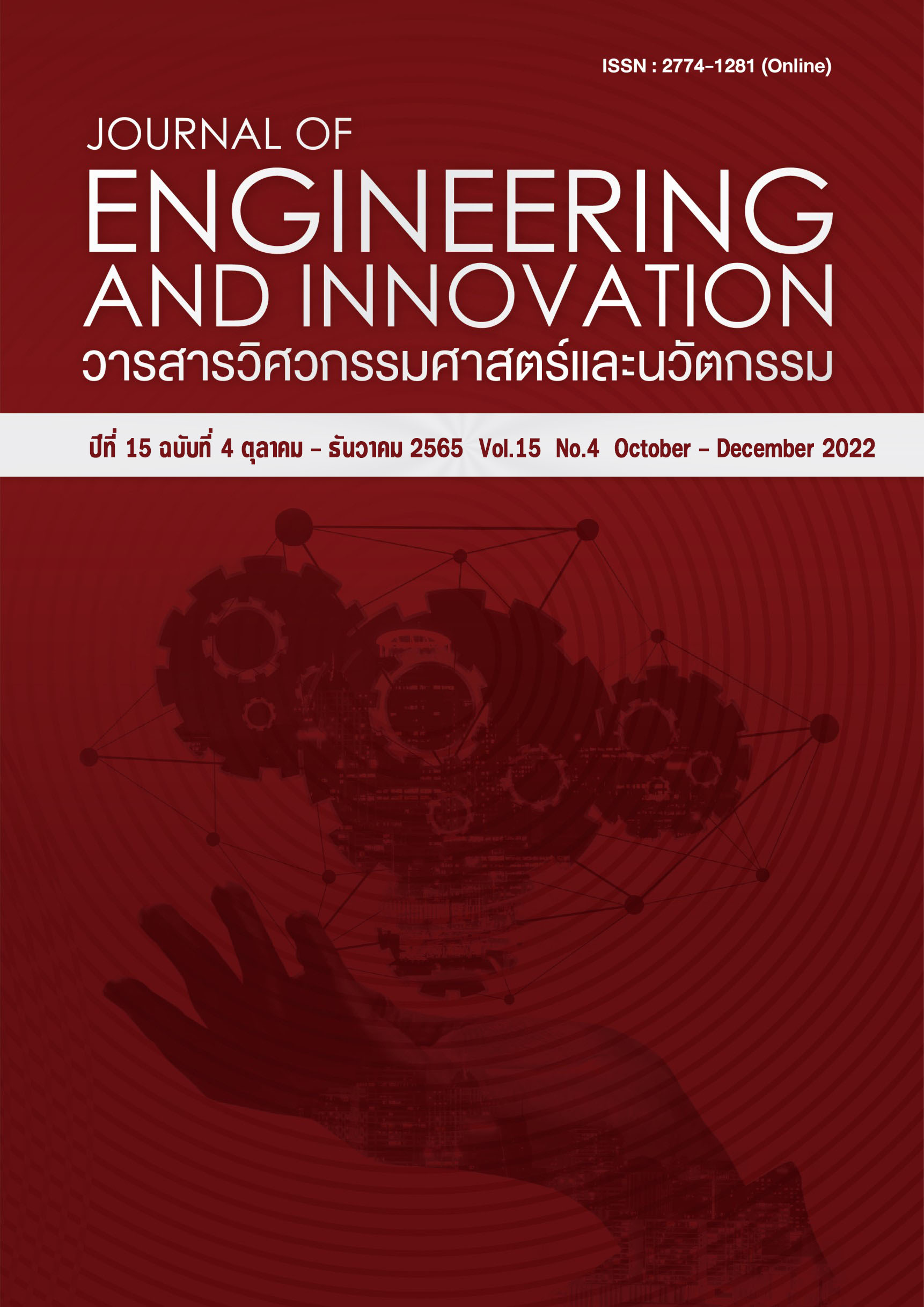การวิเคราะห์หาสมการ Z-R เพื่อใช้ในการประเมินฝนของเรดาร์ตาคลี
Main Article Content
บทคัดย่อ
ปรากฏการณ์ทางธรรมชาติที่เกี่ยวกับฝนนั้นมีความสลับซับซ้อนของขบวนการเป็นอย่างมาก ดังนั้นการตรวจวัดฝนโดยใช้สถานีโทรมาตรอัตโนมัติภาคพื้นดินที่มีความละเอียดเฉพาะจุดครอบคลุมพื้นที่ 200 cm2 ประกอบกับพื้นที่ที่ไม่มีสถานีโทรมาตรอัตโนมัติภาคพื้นดินติดตั้งในพื้นที่เพื่อตรวจวัดฝน ส่งผลให้ขาดแคลนข้อมูลฝนเชิงพื้นที่ที่ถูกต้องเพื่อนำมาใช้ในการบริหารจัดน้ำในพื้นที่ ดังนั้นในช่วง 50 ปี ที่ผ่านมาจึงได้เริ่มมีการนำเทคโนโลยีการสำรวจระยะไกลด้วยเรดาร์ตรวจอากาศเข้ามาใช้ในการตรวจวัดปริมาณฝน โดยเรดาร์ตรวจอากาศจะวัดค่าการสะท้อนกลับของคลื่นเรดาร์เมื่อกระทบกับอนุภาคของเม็ดฝน ซึ่งค่าการสะท้อนกลับของคลื่นเรดาร์นี้จะแปรผันตามขนาดและลักษณะการกระจายตัวของอนุภาคของเม็ดฝนเมื่อนำข้อมูลค่าการสะท้อนกลับของคลื่นเรดาร์มาใช้ในการประเมินปริมาณฝน ข้อมูลดังกล่าวจะถูกแปลงเป็นข้อมูลความเข้มฝน (R (มม./ชม.)) โดยใช้สมการความสัมพันธ์ Z-R (Z=aRb) การศึกษาครั้งนี้จึงได้ทำการเก็บรวบรวมข้อมูลเหตุการณ์ฝนทั้งหมด 230 เหตุการณ์ในช่วงระหว่างวันที่ 25 สิงหาคม พ.ศ. 2561 ถึง วันที่ 31 สิงหาคม พ.ศ. 2563 ซึ่งประกอบด้วยข้อมูลปริมาณน้ำฝนรายชั่วโมงจากสถานีโทรมาตรอัตโนมัติภาคพื้นดิน 174 สถานี และข้อมูลค่าการสะท้อนกลับของคลื่นเรดาร์ภายใต้รัศมีการตรวจวัด 240 กม. ของเรดาร์ตาคลี มาทำการศึกษาหาสมการความสัมพันธ์ Z-R ที่แปรเปลี่ยนตามลักษณะการกระจายตัวของอนุภาคของเม็ดฝนในแต่ละช่วงเวลาเพื่อนำมาใช้ในการประเมินฝนเทียบกับการประเมินฝนโดยใช้สมการ Z-R เฉลี่ย, Z=200R1.6 และ Z=300R1.4 ผลการศึกษาพบว่าการประเมินฝนโดยใช้สมการความสัมพันธ์ Z-R ที่แปรเปลี่ยนตามลักษณะการกระจายตัวของอนุภาคของเม็ดฝนตามค่าการสะท้อนกลับของคลื่นเรดาร์ในแต่ละวัน เมื่อพิจารณาจากค่า RMSE (Root Mean Squared Error) สามารถช่วยเพิ่มความถูกต้องในการประเมินฝนได้ [9.05%,10.68%,12.42%] , เมื่อพิจารณาจากค่า MSE (Mean Squared Error) สามารถช่วยเพิ่มความถูกต้องในการประเมินฝนได้ [18.96%,22.50,26.39%], เมื่อพิจารณาจากค่า MAE (Mean Absolute Error) สามารถช่วยเพิ่มความถูกต้องในการประเมินฝนได้ [18.59%,21.60%,25.78%] และ เมื่อพิจารณาจากค่า BIAS สามารถช่วยเพิ่มความถูกต้องในการประเมินฝนได้ [512.14%,580.58,621.36%] เมื่อเทียบกับการประเมินฝนโดยใช้สมการความสัมพันธ์ Z-R เฉลี่ย,สมการ Z=200R1.6 และ สมการ Z=300R1.4 ตามลำดับ
Article Details
เอกสารอ้างอิง
Morin E, Gabella M. Radar-based quantitative precipitation estimation over Mediterranean and dry climate regimes. J Geophys Res. 2007; 112: D20108.
Marshall J S, and Palmer W M K. The Distribution of Raindrops with Size. Journal of Meteorology. 1984; 5(4): 165-166.
Mapiam P P, Sriwongsitanon N. Climatological Z-R relationship for radar rainfall estimation in the upper Ping river basin. ScienceAsia. 2008; 34: 215-222.
Hanchoowong R, Weesakul U, Chumchean S. Bias correction of radar rainfall estimates based on a geostatistical technique. ScienceAsia. 2012; 38: 373-385.
Chantraket P, Detyothin C, Pankaew S, Kirtsaeng S. An Operational Weather Radar-Based Calibration of Z–R Relationship over Central Region of Thailand. Int J Eng. 2016; 2: 92–100.
Ramli S, Tahir W. Radar Hydrology: New Z/R Relationships for Quantitative Precipitation Estimation in Klang River Basin, Malaysia, International Journal of Environmental Science and Development. 2011; 2(3).
Ayat H, Kaviaanpour M R, Moazami S,Hong Y, Ghaemi E. Calibration of weather radar using region probability matching method (RPMM), Theor Appl Climatol. DOI 10.1007/s00704-017-2266-7.
Richards W G, Crozier C L. Precipitation measurement with a C-band weather radar in Southern Ontario. Atmos Ocean. 1983; 21: 2505–2514.
Smith J A, Krajewski W F. A modeling study of rainfall rate reflectivity relationships. Water Resour Res. 1993; 29: 2505–2514.
Tokay A, Short D A. Evidence from tropical raindrop spectra of the origin of rain from stratiform versus convective clouds. J Appl Meteorol. 1996; 35: 355–371.
Bringi V, Chandrasekar V, Hubbert J, Gorgucci E, Randeu W, Schoenhuber M. Raindrop size distribution in different climatic regimes from disdrometer and dual-polarized radar analysis. J Atmos Sci. 2003; 60: 354–365.
Lee G W, Zawadzki I. Variability of drop size distributions: time-scale dependence of the variability and its effects on rain estimation. J Appl Meteorol. 2005; 44: 241–255.
Seo D J, Breidenbach J P. Real-time correction of spatially nonuniform bias in radar rainfall data using rain gauge measurements. J Hydrometeorol. 2002; 3: 93–111.
Chumchean S, Seed A. Sharma A. Correcting of real-time radar rainfall bias using a Kalman filtering approach. J Hydrol. 2006; 317: 123–137.
Chiang Y M, Chang F J, Jou B J D, Lin P F. Dynamic ANN for precipitation estimation and forecasting from radar observations. J Hydrol. 334, 250–261, 2007
รัชเวช หาญชูวงศ์, วลัยรัตน์ บุญไทย, ศิริลักษณ์ ชุ่มชื่น. การวิเคราะห์หาค่าปรับแก้ตามเวลารายชั่วโมงโดยประยุกต์ใช้วิธี Inverse Distance Weighting เพื่อเพิ่มความถูกต้องในการประเมินฝนเรดาร์อมก๋อย. 2564; 14: 61-73.
Michelson D, Einfalt T, Holleman I, Gjertsen U, Friedrich K, Haase G, Lindskog M, Sztuc J. Weather radar data quality in Europe: Quality control and characterization, COST 717 Working Document WDF_20_200204_1. 2004.
Hydro & meteo GmbH&Co. KG. SCOUT Documentation Version 3.32. Hydro & meteo GmbH & Co. KG. Germany: 2016.
Futon RA, Breidenbach JP, Seo DJ, Miller DA, O’Brannon T. The WSD–88D rainfall algorithm. Weather Forecasting. 1998; 13: 377 -395.
Doelling I G, Joss J, Riedl J. Systematic variations of Z-R relationships from drop size distributions measured in northern Germany during seven years. Atmospheric Research. 1998; 47-48: 635- 649.
Steiner M, Smith J A. Reflectivity, rain rate, and kinetic energy flux relationships based on raindrop spectra. American Meteorological Society. 2000; 39 : 1923-1940.
Hagen M, Yuter S E. Relations between radar reflectivity, liquid water content, and rainfall rate during the MAP-SOP. Atmospheric Sciences. 2003; 128 : 477-494.
Germann U, Galli G, Boscacci M, Bolliger M. Radar precipitation measurement in a mountainous region, Quarterly Journal of the Royal Meteorological Society. 2006; 132: 1669-1692.
กรมฝนหลวงและการบินเกษตร. โครงการประเมินปริมาณน้า ฝนดว้ยเรดาร์ภาคตะวนัออก. กรมฝนหลวงและการบินเกษตร. 2557.
Mapiam P P, Methaprayum M, Bogaard T A, Schoups G, Veldhuis MC T. Citizen rain gauge improves hourly radar rainfall bias correction using a two-step Kalman filter, Hydrol Earth Syst Sci. 2022; 26: 775–794.
Seed A, Sirivarden L, Sun X, Jordan P, Elliot J. On the calibration of Australian weather radars. Technical report 02/7. 2002; 40.
Woodley W, & Herndon A. A raingage evaluation of the Miami reflectivity-rainfall rate relation. Journal of Applied Meteorology.1970; 9(2): 258-264.

